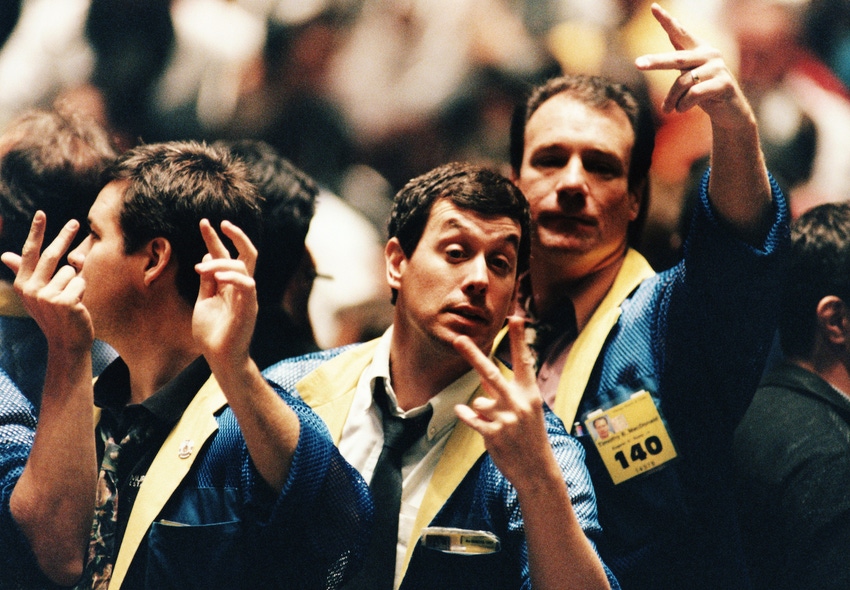
Earlier this year, a tradition that was over 150 years old came to an end, when open outcry futures trading on the Chicago Mercantile Exchange was permanently discontinued. The CME trading pits were temporarily closed in March of 2020 due to the COVID-19 pandemic but will now be closed on a permanent basis. The CME group, which manages grain and oilseed futures trading, was joined with the Chicago Board of Trade a few years ago and made the decision to switch totally to electronic futures trading for grain futures. Many grain traders, local grain elevator managers, and farm operators have fond memories of past days when a majority of grain futures were traded through face-to-face communications in the grain pits at the CBOT.
The origin of grain futures trading, and all futures trading, in the United States, traces back to 1848, which was the year that the CBOT was founded. The CBOT was established to promote commerce, as well as to have a specific market place for price discovery and transfer of risk for various commodities. In the early days of the CBOT, there were no futures contracts, and trading was simply cash contracts between buyers and sellers.
By 1865, the CBOT developed new and innovative concepts for trading commodities, which really were the cornerstones of the grain futures contracts that we utilize today. They identified standardized contracts, with specific terms for quantity, quality and delivery procedures. About that same time, the CBOT also developed terms for payment and contract settlement, and initiated procedures for margin calls. This totally changed the way commodities were sold by grain elevators and farmers, and for purchases by processing plants and other end-users. In addition, this lead to grain speculators being quite common, as well as the use of hedging, whereby grain sellers and buyers could establish a price without actually transferring the physical commodity.
Today, the concept of futures trading, hedging, and the use of standardized contracts has extended well beyond agricultural commodities and is utilized in business and commerce throughout the World. The early rules and management processes at the CBOT evolved into practices that are utilized today, such as daily position settlements on futures contracts, facilitating the paying of losses and collection of gains on contract positions. The upgrading and tweaking of these processes over the years has helped maintain and improve the overall integrity of the CBOT, and the entire futures trading industry.
In the late 1800s, and for the greater part of the next century, futures trading at the CBOT continued to thrive and grow in volume. There were many fortunes made and lost through the open outcry process in the grain pits at the CBOT. However, as technology grew across the United States in the late 1980s and throughout the 1990s, leading to many changes in all aspects of our daily lives. It also greatly affected the grain trading industry, and ultimately lead to the end of grain pit futures trading at the CBOT.
In 1987, the Chicago Mercantile Exchange developed electronic futures trading, which was initially conceived as means to provide “after-hours” market coverage for CME currency trading. In 1992, the CME launched screen-based electronic futures trading, which quickly became common-place for all types of commodities, including agricultural commodities. Electronic trading boosted volumes and revenues from futures trading, and also allowed many newcomers to enter the futures market. The use of electronic trading continued to grow rapidly in the late 1990s and early 2000s, and by 2006 the volume of electronic futures trading had surpassed the open outcry trading in grain pits at the CBOT. By early 2015, electronic futures trading had totally taken over the grain trading industry, and less than 1 percent of the total grain trading volume at the CBOT was accomplished through the open outcry trading method. This finally lead to the decision to discontinue open outcry trading on grain futures contracts at the CME.
Despite the development of the discontinuation of trading grain futures in the trading pits at the CBOT and the CME, the grain futures trading industry is alive and well. The electronic grain trading process continues to offer the same basic concepts that the open-cry grain trading did several decades ago. It serves the dual purpose of price discovery and risk transfer for commodities. It allows grain producers to lock-in a selling price well ahead of harvest, or to set a basis level for grain sales, which is the difference between the CBOT futures price and the local cash price being offered.
The use of electronic futures allows grain elevators, soybean processing plants, ethanol plants and other end users of grains to offer competitive bids to producers, well before delivery of the grain. It also allows these purchasers of grains to change their bid offers instantly as CBOT futures prices change. Livestock producers also use CBOT grain futures to lock in feed costs for livestock production, when grain prices are favorable. Feed costs are the largest expense in most livestock production systems. Livestock producers also utilize CME livestock futures to set market prices for livestock sales at profitable levels, as part of an overall risk management strategy.
The use of hedging through the CBOT futures and options grain markets have become an important grain marketing tool for grain producers in recent years. In the past few years, a successful grain marketing plan has been one of the main differences between profitable grain farming operations and those that have struggled a bit from a profitability standpoint. Typically, in years with high levels of nationwide corn and soybean production, such as 2017 and 2018, grain prices tend to peak earlier in the growing season, and then tail-off toward harvest season in the Fall. This makes it very important for producers to have the tools and confidence to forward price some of their production well before it is harvested in a given year.
The term hedging refers to setting a price on the futures market for anticipated commodities, such as corn or soybeans that are growing in the field. At some point after the crop is harvested, the hedge position is lifted, and crop is actually sold on the cash market. Even if the cash price has dropped, the producer will have a profit from the grain hedge position. Many times, the basis between the CBOT futures price and the local cash price is quite wide at harvest time. Hedging allows a farm operator to lock-in a price on the grain prior to harvest, to store the grain after harvest, and physically deliver the grain at some future time after harvest, when basis levels usually have improved.
Just as iPhones and iPads have changed the way we communicate with one another, compared to wall phones and written letters, electronic futures grain trading has changed how we set grain prices, compared the open-cry grain pits. Electronic trading makes grain trading easier, faster and more accessible, as well as improves the communications in the industry. Fortunately, the integrity of the grain trading industry is just as solid as ever, and the importance of having grain futures trading as a risk management tool is as important as ever to grain farmers, livestock producers, processors and others in the agriculture industry. However, even as we advance into a more technology-driven grain trading system, many folks will always have special memories for the "prime time” of open outcry trading in the grain pits at the CBOT, which is now part of history.
About the Author(s)
You May Also Like






